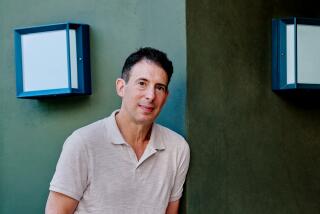BOOK REVIEW : Finding Heroes in an AIDS War Zone : AS REAL AS IT GETS The Life of a Hospital at the Center of the AIDS Epidemic by Carol Pogash Birch Lane Press $18.95; 249 pages
An interesting thing about human beings: Each one of us is separate, but if we gather together in a group, something above and beyond that happens. We form a larger personality, a collective conscious, or unconscious.
In this fascinating but depressing book, Carol Pogash chooses to look at the monumental terror of the AIDS epidemic--1 million Americans are HIV-positive right now, and “by the year 2000, a projected 30 million to 110 million people will be infected with the AIDS virus worldwide”--by keeping her point of view limited and specific. She looks only at the staff and a few of the patients at San Francisco General Hospital, a public institution that has been at the center of the epidemic from the beginning and has become an international model for the treatment of AIDS.
Much has been said about the public’s shameful neglect of people with AIDS; that the disease destroys those whom society cares least about--gay men, IV drug users, minorities, children.
A whole generation in America and the Western world grew up thinking that human health was like a car: Just cut down on your cholesterol, take some penicillin, fix the spark plugs, adjust the points and you could putter happily along for decades, until you died of old age.
AIDS, then, has been about diagnosing, identifying, treating but also coming to terms with the fact that AIDS will kill you 100% of the time, and Western science--with all its fancy technology--isn’t expected to come upwith a vaccine or a cure any time soon.
So, in 1981, the staff of San Francisco General found its collective self out on an extended blind date with death. In what might be a signature quote for this book, Dr. Andrew Moss, an epidemiologist at the hospital, summed up the attitude of the early years:
“At least one-third of everybody’s brain was saying to itself at all times, ‘I’m going to be a star! If I live, I’m going to be a star.’ And another third of their brain was saying, ‘My God! Let me out of here! Help!’ And another third of their brain was saying, ‘There’s a lot of sick people. We better do something.’ ”
Ironically, the staff member who most became a “star” out of the epidemic was a woman who represented--rightly or wrongly--stark terror.
Dr. Lorraine Day, an orthopedic surgeon who liked to operate in high-heeled shoes, ended up on “60 Minutes” demonstrating an outlandish spacesuit for operating on AIDS patients. If blood was in the air, or splashing about, she argued, all caregivers were in great risk of contracting the virus.
Other staff members grew to detest her, the author notes, but undeniably the flashy surgeon did have a point. The central character in this narrative, which covers a decade but concentrates on “the beginning” and on the very recent past, is a naive young nurse who sticks herself with an AIDS-tainted needle and soon tests HIV-positive. (There are 31 documented cases and 65 other “possibles” to whom this has happened.)
What’s a caregiver to do when caring for these patients can mean your own death?
Forming a collective “self,” staff members demonstrated every level and permutation of human behavior.
Day’s extreme position freed another surgeon to behave like a selfless saint who would “operate on anyone.” Nurses got bright ideas to put together an AIDS ward that became both a haven and a support group. A Catholic priest refused to give a dying AIDS patient the last rites because he himself was so afraid of death. A reclusive scientist developed a drug called Compound Q and was attacked for his secrecy both by AIDS activists (because he kept the product a secret for so long) and the medical Establishment (because he didn’t adhere to strict scientific methodology).
A first generation of well-educated young gay men died, and the wards filled up with rowdy, bad-tempered drug users. Still, nobody got around to changing the IV needle procedures.
History is happening to us, and we don’t have a handle on it; we can’t seem to get a grip. The author makes no judgments here; she just poses that Jacqueline Kennedy question: When the assassin’s bullet comes, would you cover your husband or bail out of the car?
You can’t judge other people on these issues. You can only hope that if you were a priest, you’d give the last rites. If you were a surgeon, you’d go on operating. If you were that nurse with the needle stick, you’d go on working. But we never know if we pass or flunk these tests until they happen to us.
With the notable exception of Day, the staff of San Francisco General have made made themselves into heroes, day after defeating day.
More to Read
Sign up for our Book Club newsletter
Get the latest news, events and more from the Los Angeles Times Book Club, and help us get L.A. reading and talking.
You may occasionally receive promotional content from the Los Angeles Times.








